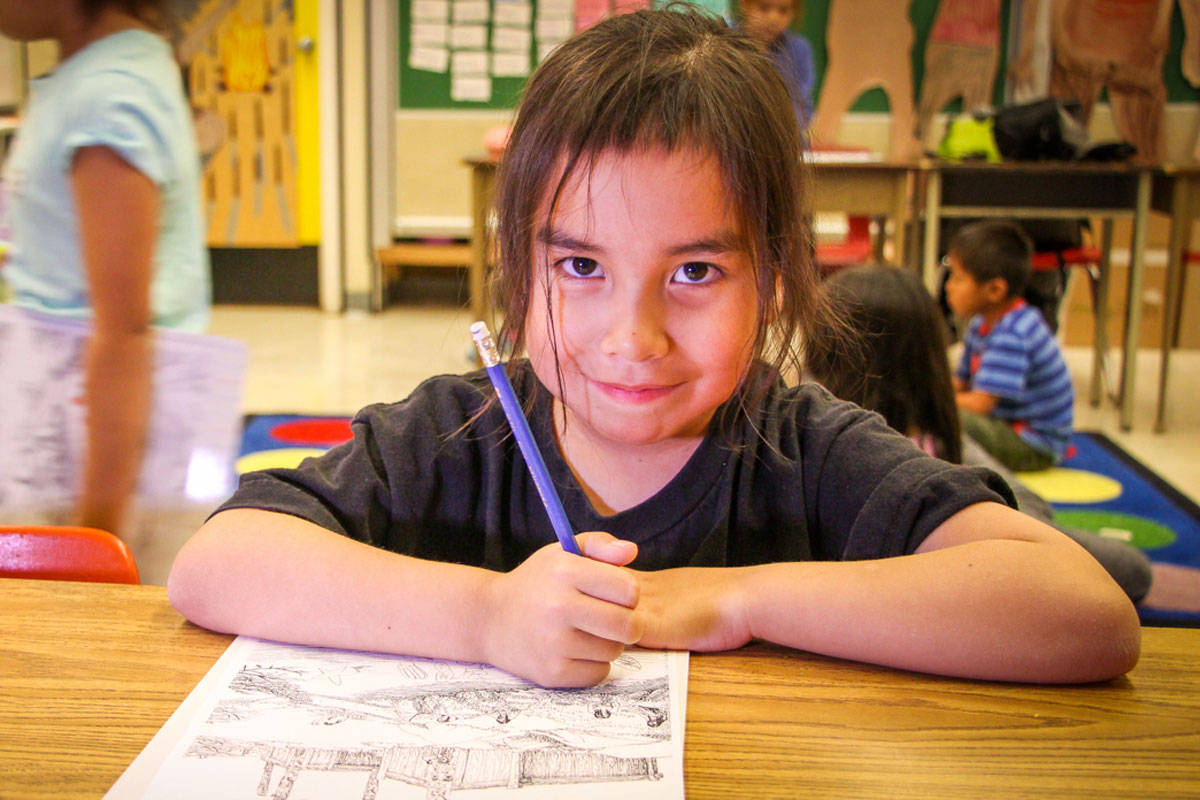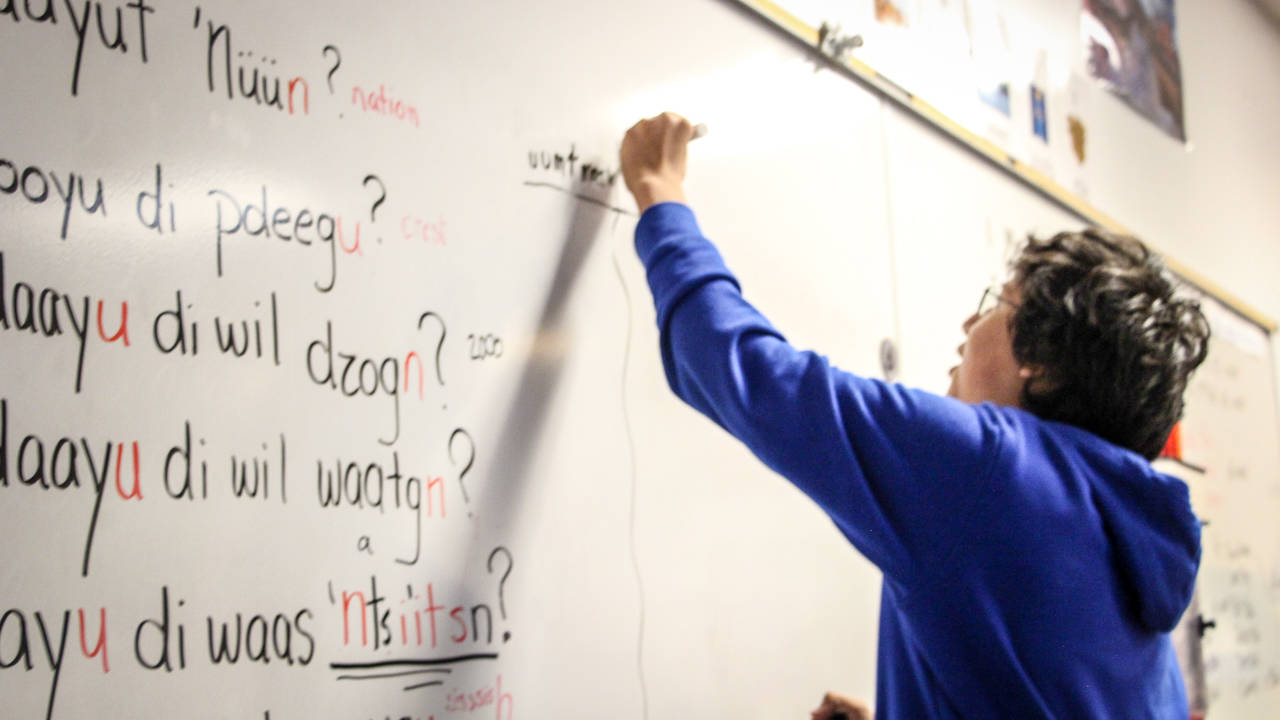“K’üül, gup’l, k’wilii, txaapx, ksduuns.”
When asked, Grade 3 students in a Pineridge Elementary School class enthusiastically count from one to five. But in this class, the students learned more than how to count, they were introduced to the origins of the tides.
“The water moving back and forth like that, up and down, is the tide, we’re going to talk about where those tides came from and why we have those tides,” said Lindsay Reeves, the Sm’algyax teacher, who has the children sitting in a circle with battery-powered candles glowing in the centre.
| Teacher Kelli Clifton introduces the "Grade 1 and 2 students listen to a story about the tides in their Sm'algyax class at Pineridge Elementary School. (Shannon Lough/The Northern View) |
One girl rasies her hand, “The waterfront Rupert beach is closed,” she said. Ms. Reeves nods. “We don’t have too many places where we can go to the beach anymore,” and then continues with the story in English, with Mr. Ben Spencer, reading the story in Sm’algyax.
“I think it’s always important to give context to the words that the kids are learning,” Ms. Reeves said after the class. She always wanted to learn the language and now it’s a part of her job.
As Ms. Reeves improves her grasp on the language, she works with a fluent speaker, Mr. Spencer, who is from Kitkatla. He comes to her classes twice a week, and when he is away he records his voice so the students could hear the language in fluid sentences.
All students in School District 52 take Sm’algyax from kindergarten to Grade 5 when they have a choice whether to take French as a second language or continue taking Sm’algyax — choice that is clear for many, with all Grade 5-12 Sm’algyax classes full.
PART I: How Prince Rupert schools teach Indigenous language to hundreds of students
“We never did this when I was a kid so I think it’s really exciting that kids get a chance to be able to learn this,” Ms. Reeves said, who grew up in Prince Rupert.
She’s heard feedback from parents who say their child is speaking some words at home.
“I think being exposed to it is important in a place that we live in where there are so many First Nation students it educates kids not only about language but about culture.”
Counting in high school
On the third floor at Charles Hays Secondary School, there is a room dedicated to Sm’algyax lessons lead by two teachers, Donna McNeil-Clark and Alex Campbell.
When asked what the difference is from high school and elementary school, students agree “it’s way harder.”
“We learned how to say words in possession and we had to write our families names down,” said Evelyn Johnson-Clark, a Grade 9 student.
| Grade 9 student Evelyn Johnson-Clark says that Sm'algyax is her favourite class and she intends to take it all the way through high school. (Shannon Lough/The Northern View) |
She points to the family charts on the wall behind her that follow the mother’s crest. Johnson-Clark is from Lax Kw’alaams and has been studying Sm’algyax since Grade 2, before the school district included the language teachings for all schools from kindgergarten and up.
“In elementary we were learning colours and numbers and now we’re learning more everyday words like Christmas words and protocol speech. We’ve learned how to count up to 1,000 and further than that too,” she said.
This is her favourite class and she plans to take the class all the way through high school. Some of her classmates are on the same page.
READ MORE: Relearning Nisga’a
Caden Pagens has taken Sm’algyax since kindergarten at Roosevelt Elementary School, and although the words are now more complex, he wants to take the classes all the way through. “To learn about where I come from and my culture,” Pagens said.
Rylan Adams, who sits next to Caden, echoes his classmate.
“I want to learn more about my culture and my people,” he said.
French and Sm’algyax classes
Tsimshian culture and words have also entered French classrooms at the high school. Nancy Griffith-Zahner has been attending the evening adult language classes, and she found ways to bring what she’s learned into her core French classroom.
She tries to teach material that could only be taught in Prince Rupert, not a generic boxed French course.
“Of course we live on Tsimshian land and to not acknowledge the ownership of that land and also the ways of knowing and teaching and learning that the Indigenous people have used for thousands of years would just be disrespectful and would be a waste of an opportunity to become a better teacher,” she said.
This year, she thought they should create motivational posters with a Sm’algyax word at the top for a heroic quality and the French translation below, with an artist’s depiction in between. Kelli Clifton, who is a Sm’algyax teacher and who was in French immersion as a student, drew the images.
The five words were respect, reconciliation, health or clean heart, family and nature.
With the permission and aid from the Ts’msyen Sm’algyax Language Authority and Wap Sigatgyet, the Aboriginal education office, to agree on the words and pronunciation, the posters were printed 18 months later.
“French is not more important, not in Prince Rupert. That’s some of the ways that we try to have French be of service,” Mme. Griffith-Zahner said.
Language and culture
It’s a Wednesday, and students were deep into a game of jeopardy using Sm’algyax words. Their teacher, Ms. McNeil-Clark, walked around room watching their engagment and assisting when needed.
| Donna McNeil-Clark is the Sm'algyax language teacher, with Alex Campbell, at Charles Hays Secondary School. (Shannon Lough / The Northern View) |
She’s been teaching Sm’algyax at the high school with Mr. Campbell since Oct. 2011. She is still learning the language, much like Ms. Reeves and the students, which is why working with a fluent speaker is so essential. When Ms. McNeil-Clark first started working with Mr. Campbell she told him:
“I consider you the teacher, I know the newest ways to teach language so I think if we work together we will be able to come up with something that we’ll both be proud of and that’s basically how our partnership started,” she said.
Ms. McNeil-Clark comes from a family of master carvers and she has always been interested in the history of the area, and has wanted to pass it onto the children in the community so they can also see what a rich history they have.
“Language and culture go hand in hand,” she said.
| Grade 9 students play a game of jeopardy in Sm’algyax class at Charles Hays Secondary School. (Shannon Lough / The Northern View) |
“When I teach them their protocol speech, their feast hall speech, and to introduce themselves, who they are, what crest they are and where their grandmother was born and who their grandmother is, it gives them a lot of pride to be able to say it in their language. That’s when I see the little light turn on…Because it’s talking about themselves and they’re starting to learn about their history.”
Part 1: How Prince Rupert schools teach Indigenous language to hundreds of students
Part III: Saving an Indigenous language by teaching adults and creating an app
shannon.lough@thenorthernview.com
Like us on Facebook and follow us on Twitter

